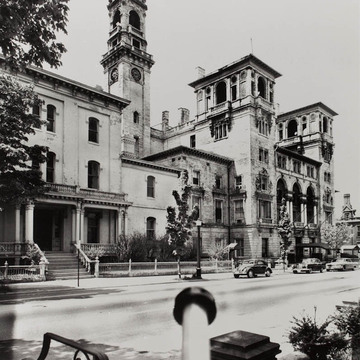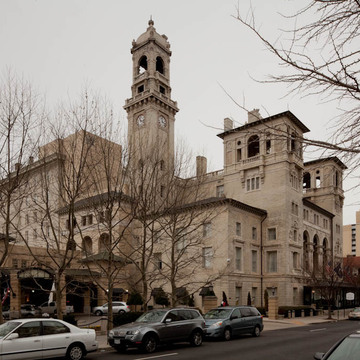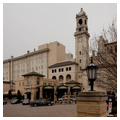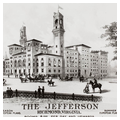The grand hotel of Richmond for over a century, the Jefferson Hotel was commissioned by Major Lewis Ginter to be the showplace for the city. Carrère and Hastings, fresh from their triumphs at St. Augustine, Florida, created a Beaux-Arts confection that drew upon the Villa Medici in Rome for the West Franklin Street facade and Spanish buildings for the towers. The steel frame is covered in a pearly white brick with white terra-cotta decoration from the Perth Amboy Terra Cotta Company. When it opened the Jefferson had 342 guest rooms, electric lighting, central heating, and hot and cold water in each room, and a grand lobby reached from West Franklin Street. The hotel was completed a few weeks ahead of schedule so that the wedding reception of Charles Dana Gibson and Irene Langhorne (his model for the “Gibson Girl”) could be held there. A fire in 1901 destroyed portions of the central and south wings, and Norfolk architect John Kevan Peebles rebuilt those sections and created the present interior with its grand staircase and lobby. This spatial sequence became one of the best-known interiors in the city, the scene of many parties, grand entrances (and exits), and the set for several movies. After World War II, the hotel declined and in the 1970s was closed and slated for demolition. R. W. S. Partners purchased the hotel and renovated it, changing the entrance to the side to better accommodate the automobile.
You are here
Jefferson Hotel
1893–1895, Carrère and Hastings. 1901–1907, John Kevan Peebles. c. 1985, renovation. 1996–2000, entrance court, pool house, and restaurant addition, Marcellus Wright, Cox and Smith. 101 block of W. Franklin St. (entire block, bounded by Franklin, Jefferson, West Main, and Adams sts.)
If SAH Archipedia has been useful to you, please consider supporting it.
SAH Archipedia tells the story of the United States through its buildings, landscapes, and cities. This freely available resource empowers the public with authoritative knowledge that deepens their understanding and appreciation of the built environment. But the Society of Architectural Historians, which created SAH Archipedia with University of Virginia Press, needs your support to maintain the high-caliber research, writing, photography, cartography, editing, design, and programming that make SAH Archipedia a trusted online resource available to all who value the history of place, heritage tourism, and learning.























